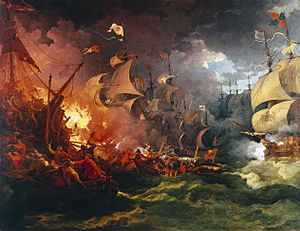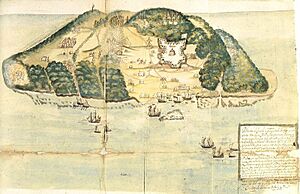1635 Capture of Tortuga facts for kids
The 1635 Capture of Tortuga was a successful attack on the island of Tortuga. At the time, Tortuga was a settlement for English and French planters, pirates, and buccaneers. It was also linked to the Providence Island colony. The attack caused many casualties for the settlers. It also cut off Tortuga's connection to Providence Island. This event led Tortuga to become even more focused on piracy and buccaneering.
Quick facts for kids 1635 Capture of Tortuga |
|||||||
|---|---|---|---|---|---|---|---|
| Part of Thirty Years' War | |||||||
 Defeat of the Spanish Armada / 1796 oil on canvas by Philip James de Loutherbourg / via Royal Mus. Greenwich |
|||||||
|
|||||||
| Belligerents | |||||||
| Commanders and leaders | |||||||
|
|||||||
| Units involved | |||||||
|
4 bajeles | ||||||
| Strength | |||||||
|
|
||||||
| Casualties and losses | |||||||
|
|
||||||
|
|||||||
Contents
Tortuga's Early Days
English, French, and Dutch buccaneers settled on Tortuga Island in the early 1600s. They lived by hunting wild animals, cutting wood for dye, and piracy. In 1630, about 150 English tobacco farmers joined them. These farmers came from St. Kitts and were led by Anthony Hilton.
The new settlers quickly made their colony official. They joined with the Providence Island colony. In 1631, Providence Island made Tortuga a part of its territory. They called it "Association." Providence Island helped with defense and labor. Hilton and Christopher Wormeley were put in charge. Wormeley became governor in 1634 after Hilton died.
A Spy's Report
Providence Island sent workers to Tortuga, including John Murphy and his cousin. They were Irish Catholics. When Wormeley became governor, many people had to take loyalty oaths. Murphy and his cousin refused. His cousin died, and Murphy escaped. He went to Cartagena and then to Santo Domingo.
In Santo Domingo in 1634, Murphy told the Spanish authorities about Tortuga. He said there were about 300 people on the island. This included old people, young people, and servants. They had farms and traded with ships from many nations. He also said they had an English governor.
Murphy reported that the settlers were not ready for a fight. He said they lacked military training. However, there was a fort in the port with six cannons. The governor's house had some muskets. About 30 enslaved Africans helped with the farms. The settlers also went to Hispaniola to get meat and other supplies.
After hearing this, Alonso de Cereceda, the acting governor, held a war council. They decided to remove the "enemy" from Tortuga. They wanted to stop them from growing stronger. They also wanted to protect their trade. Tortuga was too close to the shipping routes to Cuba and Cartagena. The settlers could easily steal from Spanish ships.
The Spanish Attack
Setting Sail
Francisco Turrillo and 50 soldiers left Santo Domingo on January 4, 1635. They had four ships. They planned to meet Ruy Fernández de Fuenmayor and his 150 lancers. Their meeting point was Port Bayaha. The officers planned their attack there. Soon after, they sailed northwest along the northern coast of Hispaniola.
The Capture of Tortuga
On January 21, 1635, Fuenmayor's fleet crossed the Tortuga Channel at night. They aimed for the island's southern port. However, the pilot ran the ships aground. This caused a lot of noise. Four merchant ships in the harbor were alerted. A confused fight began. Sailors rushed to the fort and sounded the alarm. The Spanish prepared their attack. Most used the ships' cannons. A small group went to the beach in canoes. Both sides had their first casualties in this confusion.
The fort's bugles woke the settlement. French and English residents quickly gathered their valuables. They tried to escape in a hurry. Governor Wormeley also tried to flee. He managed to get away before Fuenmayor arrived. Fuenmayor, Turrillo, and Frías, with 24 men, landed near the settlement. They marched towards the Governor's house. An unknown resident fought back but was quickly defeated. With this person gone, Fuenmayor began to destroy and burn the settlement. They also captured anyone they found. Meanwhile, the Spanish fleet took the fort and the port. This forced the merchant ships to retreat.
By daybreak on January 22, 1635, most settlers had escaped. They reportedly used small canoes to reach Hispaniola. Fuenmayor's men then went deeper into Tortuga. They had orders to burn all fields and houses.
The last part of the campaign happened on January 23, 1635. About 190 settlers had decided to fight the Spanish instead of fleeing. They planned to march towards Fuenmayor's camp that day. But the Spanish general found out about their plan. He met the settlers, who had muskets, halfway. The fight was quick and fierce. The Spanish caused many losses to the settlers. They themselves had only a few casualties.
What Happened Next
On January 27-28, 1635, the Spanish ships finally entered the port. Fuenmayor spent the next few days searching Tortuga. Then he left, with his men and prisoners following soon after. The 39 prisoners were forced to do hard labor. They built fortifications in Santo Domingo.
On April 10, 1635, the leaders of the Providence Island colony removed Wormeley from his job. They banished him from Tortuga. This was because of his "cowardice and negligence" in losing the island. He is believed to have moved to York County, Virginia. There, he held several public positions.
Some settlers who hid on the island were hunted down. However, a few managed to stay hidden until the Spanish left. Since no Spanish soldiers stayed on Tortuga, the island was likely resettled within a few months. This happened in mid- or late 1635.
Lasting Impact
The capture was seen as a "complete success." The men who fought well were honored. Fuenmayor was promoted to governor of Venezuela. This success may have encouraged Spain to attack other places. These included Dutch-held Curaçao and English-held Providence Island.
Wormeley, on the other hand, was said to have shown "the utmost cowardice."
Fuenmayor's attack helped change Tortuga. It went from a mix of plantations and pirate settlements to a "true pirate stronghold." The attack removed Providence Island's control. It also led tobacco farmers to leave. This left mainly pirates and buccaneers on the island.


